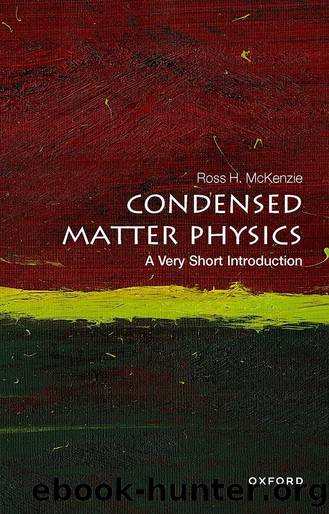Condensed Matter Physics by Ross H. McKenzie

Author:Ross H. McKenzie [McKenzie, Ross]
Language: eng
Format: epub
ISBN: 9780192584137
Publisher: OUP Oxford
Published: 2023-04-19T00:00:00+00:00
Creating Flatland in a laboratory
As a result of the painstaking work and ingenuity of many scientists, it is possible to fabricate materials that are essentially one-dimensional or two-dimensional. For example, the electrons in these materials can only move in one or two directions. We have already come across one example of a two-dimensional material: graphene, a single layer of carbon atoms.
Suppose a perfect crystal is cut in two. The surface of a piece is two-dimensional. It can be used as a substrate to create a two-dimensional system. For example, liquid helium placed on a graphite surface can be adjusted in quantity to create a single layer of helium atoms. This has led to studies of superfluids in two dimensions showing that the nature of the superfluid state and the transition to it are different from that in three dimensions.
It is also possible to make layered materials to which layers of atoms are added one layer at a time. By varying the chemical composition of different layers, interfaces can be created with unique two-dimensional properties. A specific example of this is called a semiconductor heterojunction, in which a gas of electrons is trapped at the interface between two different semiconductor materials. The electrons can then only move in directions parallel, but not perpendicular, to the interface. These two-dimensional electron gases exhibit new states of matter, known as quantum Hall states, which we will come to later.
Another class of materials is described as quasi-two-dimensional. They are three-dimensional crystals composed of layers of atoms in which there are only weak interactions between the neighbouring layers. Graphite is an example; it is a crystal composed of layers of graphene. If the interactions between the layers are weak enough, many of the properties of the material may be similar to those of a single layer. Later in this chapter, we will look at a class of superconducting materials that are quasi-two-dimensional. Chemists have also made crystals that consist of chains of atoms and are classified as quasi-one-dimensional materials.
Download
This site does not store any files on its server. We only index and link to content provided by other sites. Please contact the content providers to delete copyright contents if any and email us, we'll remove relevant links or contents immediately.
The Complete Stick Figure Physics Tutorials by Allen Sarah(7336)
Secrets of Antigravity Propulsion: Tesla, UFOs, and Classified Aerospace Technology by Ph.D. Paul A. Laviolette(5332)
Thing Explainer by Randall Munroe(3909)
The River of Consciousness by Oliver Sacks(3572)
The Order of Time by Carlo Rovelli(3162)
How To by Randall Munroe(3074)
A Brief History of Time by Stephen Hawking(2991)
I Live in the Future & Here's How It Works by Nick Bilton(2958)
What If?: Serious Scientific Answers to Absurd Hypothetical Questions by Randall Munroe(2667)
The Great Unknown by Marcus du Sautoy(2661)
Midnight in Chernobyl by Adam Higginbotham(2515)
Blockchain: Ultimate Step By Step Guide To Understanding Blockchain Technology, Bitcoin Creation, and the future of Money (Novice to Expert) by Keizer Söze(2467)
Networks: An Introduction by Newman Mark(2382)
The Meaning of it All by Richard Feynman(2318)
Easy Electronics by Charles Platt(2308)
The Tao of Physics by Fritjof Capra(2247)
Midnight in Chernobyl: The Untold Story of the World's Greatest Nuclear Disaster by Adam Higginbotham(2195)
When by Daniel H Pink(2098)
Introducing Relativity by Bruce Bassett(2097)
